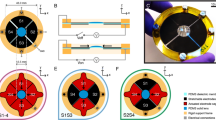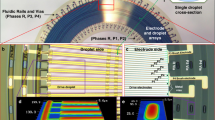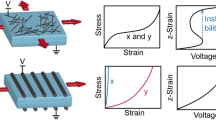Abstract
Electrostatic multilayer systems, which often employ thin polymer films in combination with displaceable insulating fluids, can enable actuation in applications such as soft robotics. Driven by high electric fields, they provide strong performance in terms of power density, actuation strain and speed, but suffer from rapid force decay due to interfacial charging. High-frequency polarity inversion of driving voltages is a remedy, but involves large power consumption and unfavourable force oscillations. Here we report a theoretical and experimental framework for the force behaviour in generic solid/liquid-dielectric multilayer stacks independent of actuator design and solely based on their dielectric properties. We use this model to develop materials-based solutions, which rely on matching the bulk charge relaxation rates of the constituent dielectrics, for a variety of soft actuator systems: tunable lenses, artificial muscles and haptic devices. The approach provides indefinite, steady force output under constant-voltage operation, with up to 1,000-fold power loss reduction compared with unmatched material combinations.
This is a preview of subscription content, access via your institution
Access options
Access Nature and 54 other Nature Portfolio journals
Get Nature+, our best-value online-access subscription
$29.99 / 30 days
cancel any time
Subscribe to this journal
Receive 12 digital issues and online access to articles
$119.00 per year
only $9.92 per issue
Buy this article
- Purchase on Springer Link
- Instant access to full article PDF
Prices may be subject to local taxes which are calculated during checkout




Similar content being viewed by others
Data availability
The data that support the plots within this paper and other findings of this study are available from the corresponding authors on reasonable request.
References
Rus, D. & Tolley, M. T. Design, fabrication and control of soft robots. Nature 521, 467–475 (2015).
Rothemund, P. et al. Shaping the future of robotics through materials innovation. Nat. Mater. 20, 1582–1587 (2021).
Whitesides, G. M. Soft robotics. Angew. Chem. Int. Ed. 57, 4258–4273 (2018).
Polygerinos, P. et al. Soft robotics: review of fluid-driven intrinsically soft devices; manufacturing, sensing, control, and applications in human-robot interaction. Adv. Eng. Mater. 19, 1700016 (2017).
Cianchetti, M., Laschi, C., Menciassi, A. & Dario, P. Biomedical applications of soft robotics. Nat. Rev. Mater. 3, 143–153 (2018).
El-Atab, N. et al. Soft actuators for soft robotic applications: a review. Adv. Intell. Syst. 2, 2000128 (2020).
Li, M., Pal, A., Aghakhani, A., Pena-Francesch, A. & Sitti, M. Soft actuators for real-world applications. Nat. Rev. Mater. 7, 235–249 (2022).
Rich, S. I., Wood, R. J. & Majidi, C. Untethered soft robotics. Nat. Electron. 1, 102–112 (2018).
Ilami, M., Bagheri, H., Ahmed, R., Skowronek, E. O. & Marvi, H. Materials, actuators, and sensors for soft bioinspired robots. Adv. Mater. 33, e2003139 (2021).
Heiden, A. et al. 3D printing of resilient biogels for omnidirectional and exteroceptive soft actuators. Sci. Robot. 7, eabk2119 (2022).
Wehner, M. et al. An integrated design and fabrication strategy for entirely soft, autonomous robots. Nature 536, 451–455 (2016).
Yang, T. H., Shintake, J., Kanno, R., Kao, C. R. & Mizuno, J. Low-cost sensor-rich fluidic elastomer actuators embedded with paper electronics. Adv. Intell. Syst. 2, 2000025 (2020).
Lendlein, A. & Gould, O. E. C. Reprogrammable recovery and actuation behaviour of shape-memory polymers. Nat. Rev. Mater. 4, 116–133 (2019).
Chen, C. & Yi, Z. G. Photostrictive effect: characterization techniques, materials, and applications. Adv. Funct. Mater. 31, 2010706 (2021).
Sitti, M. & Wiersma, D. S. Pros and cons: magnetic versus optical microrobots. Adv. Mater. 32, e1906766 (2020).
Mao, G. Y. et al. Ultrafast small-scale soft electromagnetic robots. Nat. Commun. 13, 4456 (2022).
Bar-Cohen, Y. (ed.) in Electroactive Polymer (EAP) Actuators as Artificial Muscles: Reality, Potential, and Challenges 3–50 (SPIE, 2004).
Haines, C. S. et al. Artificial muscles from fishing line and sewing thread. Science 343, 868–872 (2014).
Haines, C. S. et al. New twist on artificial muscles. Proc. Natl Acad. Sci. USA 113, 11709–11716 (2016).
Liu, C., Qin, H. & Mather, P. T. Review of progress in shape-memory polymers. J. Mater. Chem. 17, 1543–1558 (2007).
Bluett, S., Helps, T., Taghavi, M. & Rossiter, J. Self-sensing electro-ribbon actuators. IEEE Robot. Autom. Lett. 5, 3931–3936 (2020).
Ly, K. et al. Miniaturized circuitry for capacitive self-sensing and closed-loop control of soft electrostatic transducers. Soft Robot. 8, 673–686 (2021).
Rothemund, P., Kellaris, N., Mitchell, S. K., Acome, E. & Keplinger, C. HASEL artificial muscles for a new generation of lifelike robots—recent progress and future opportunities. Adv. Mater. 33, 2003375 (2021).
Moretti, G., Duranti, M., Righi, M., Vertechy, R. & Fontana, M. Analysis of dielectric fluid transducers. In Proc. SPIE 10594, Electroactive Polymer Actuators and Devices (EAPAD) XX (ed. Bar-Cohen, Y) 105940W (SPIE, 2018).
Acome, E. et al. Hydraulically amplified self-healing electrostatic actuators with muscle-like performance. Science 359, 61–65 (2018).
Kellaris, N., Venkata, V. G., Smith, G. M., Mitchell, S. K. & Keplinger, C. Peano-HASEL actuators: muscle-mimetic, electrohydraulic transducers that linearly contract on activation. Sci. Robot. 3, eaar3276 (2018).
Taghavi, M., Helps, T. & Rossiter, J. Electro-ribbon actuators and electro-origami robots. Sci. Robot. 3, eaar3276 (2018).
Wang, X. R., Mitchell, S. K., Rumley, E. H., Rothemund, P. & Keplinger, C. High-strain Peano-HASEL actuators. Adv. Funct. Mater. 30, 1908821 (2020).
Sirbu, I. D. et al. Electrostatic bellow muscle actuators and energy harvesters that stack up. Sci. Robot. 6, eaaz5796 (2021).
Yoder, Z. et al. A soft, fast and versatile electrohydraulic gripper with capacitive object size detection. Adv. Funct. Mater. 33, 2209080 (2022).
Hartmann, F., Penkner, L., Danninger, D., Arnold, N. & Kaltenbrunner, M. Soft tunable lenses based on zipping electroactive polymer actuators. Adv. Sci. 8, 2003104 (2021).
Leroy, E., Hinchet, R. & Shea, H. Multimode hydraulically amplified electrostatic actuators for wearable haptics. Adv. Mater. 32, e2002564 (2020).
Sirbu, I. D. et al. Electrostatic actuator for tactile display based on hydraulically coupled dielectric fluids and soft structures. Electroact. Polym. Actuators Devices (EAPAD) XXI 10966, 334–339 (2019).
Han, A. K., Ji, S., Wang, D. X. & Cutkosky, M. R. R. Haptic surface display based on miniature dielectric fluid transducers. IEEE Robot. Autom. Lett. 5, 4021–4027 (2020).
Helps, T., Romero, C., Taghavi, M., Conn, A. T. & Rossiter, J. Liquid-amplified zipping actuators for micro-air vehicles with transmission-free flapping. Sci. Robot. 7, eabi8189 (2022).
Duranti, M., Righi, M., Vertechy, R. & Fontana, M. A new class of variable capacitance generators based on the dielectric fluid transducer. Smart Mater. Struct. 26, 115014 (2017).
Iwamoto, M. in Encyclopedia of Nanotechnology (ed. Bhushan, B.) 1904–1915 (Springer, 2016).
Srinivasan, R. & Fasmin, F. Introduction to Electrochemical Impedance Spectroscopy 1st edn (CRC Press, 2021).
Lvovich, V. F. Impedance Spectroscopy: Applications to Electrochemical and Dielectric Phenomena (Wiley, 2012).
Kremer, F. & Schönhals, A. Broadband Dielectric Spectroscopy (Springer, 2003).
Brock, J. Electrochemical Impedance Spectroscopy: Methods, Analysis, and Research (Nova Science Publishers, 2017).
Barsoukov, E. & Macdonald, J. R. Impedance Spectroscopy: Theory, Experiment, and Applications 3rd edn (Wiley, 2018).
Prodromakis, T. & Papavassiliou, C. Engineering the Maxwell-Wagner polarization effect. Appl. Surf. Sci. 255, 6989–6994 (2009).
Kellaris, N., Venkata, V. G., Rothemund, P. & Keplinger, C. An analytical model for the design of Peano-HASEL actuators with drastically improved performance. Extreme Mech. Lett. 29, 100449 (2019).
Rothemund, P., Kirkman, S. & Keplinger, C. Dynamics of electrohydraulic soft actuators. Proc. Natl Acad. Sci. USA 117, 16207–16213 (2020).
Bartnikas, R. Electrical Insulating Liquids (ASTM, 1994).
Tenbohlen, S. & Koch, M. Aging performance and moisture solubility of vegetable oils for power transformers. IEEE Trans. Power Del. 25, 825–830 (2010).
Rumley, E. H. et al. Biodegradable electrohydraulic actuators for sustainable soft robots. Sci. Adv. 9, eadf5551 (2023).
Acknowledgements
We thank NATURABIOMAT GmbH, especially Managing Director G. Margreiter, for fruitful discussions and providing NATURAPACKAGING (BP) films. M.K. acknowledges support from the European Research Council Starting Grant ‘Gel-Sys’ under grant agreement no. 757931 and support from the European Union’s Horizon 2020 research and innovation programme under grant agreement no. 101016411. I.-D.S., G.M. and M.F. acknowledge support from the Italian Ministry of Education, University and Research (MUR), under the Program Department of Excellence, awarded to the Department of Industrial Engineering of the University of Trento, Italy, and to the Department of Excellence of Robotics and AI of Scuola Superiore Sant’Anna, Italy. M.F. acknowledges support from the project ‘Sviluppo e valutazione socio-tecno-economica-ambientale di nuove tecnologie basate su Materiali Multifunzionali per la conversione di Energia Rinnovabile’ under project nr. MAMER21MF, given by the ‘Programma Nazionale per la Ricerca (PNR)’ (DM no. 737/2021).
Author information
Authors and Affiliations
Contributions
M.K., M.F., R.S. and G.M. formulated the goals of this research. M.K. and M.F. planned and coordinated the research activities. M.K., M.F., R.S. and N.A. supervised the work. N.A. and G.M. developed the analytical framework and the equivalent circuit models. R.S., I.-D.S., D.P. and L.P. designed the experiments and built most of the experimental test benches. I.-D.S. and R.S. performed the force measurements in dielectric stacks. R.S. and D.P. performed the high-voltage conductivity and power loss measurements. R.S., D.P. and I.-D.S. performed the dielectric spectroscopy measurements to determine the complex permittivities. L.P. and I.-D.S fabricated and tested the demonstrators. I.-D.S., D.P. and R.S. curated the data. D.P., N.A., I.-D.S., R.S., L.P. and G.M. analysed and processed the experimental data. N.A., D.P., R.S., D.D. and G.M. validated the models. D.P., N.A., I.-D.S., D.D. and L.P. visualized the data. I.-D.S., N.A., D.P. and D.D. wrote the initial paper draft. All authors contributed to reviewing and editing and accepted the final paper.
Corresponding authors
Ethics declarations
Competing interests
The authors declare no competing interests.
Peer review
Peer review information
Nature Electronics thanks the anonymous reviewers for their contribution to the peer review of this work.
Additional information
Publisher’s note Springer Nature remains neutral with regard to jurisdictional claims in published maps and institutional affiliations.
Extended data
Extended Data Fig. 1 Force response of two different multilayer stacks.
Smooth constant force for a stack with BP under constant 8 kV and force spikes (recalculated from the opto-electronically recorded displacement using static calibration) at the moments of inversion (seconds 306 and 307) for PI-based dielectric stack under 8 kV square wave with 2 s period.
Extended Data Fig. 2 Model validation.
a, The decay of the electric field \({E}_{{\rm{L}}}-{E}_{{\rm{L}},\infty }\propto \sqrt{F}-\sqrt{{F}_{\infty }}\) is close to a single-exponential for each dielectric material combination. All dielectric films are tested in combination with FR3 oil except P(VDF-TrFE-CFE) which is combined with paraffin oil. b, Fits of force responses for each tested material combination (films are color-coded in the 1st panel). The ‘Fit’ curves approximate the experimental data by optimizing the fitting parameters F0, F∞, and τ in Eq. (1), whereas the ‘Prediction’ curves use their theoretical values, independently calculated with the material parameters ε and σ from the dielectric spectroscopy and conductivity measurements.
Extended Data Fig. 3 Frequency dependence of force responses.
a-f, Responses of BP, PET, PI, PVDF and BOPP film combined with FR3 oil as well as P(VDF-TrFE-CFE) combined with paraffin oil when driven with bipolar square wave high voltage of 8 kV and periods T of 20, 120, and 1200 s.
Extended Data Fig. 4 Fitting of square wave high voltage response of multilayer stacks.
a, Highly insulating film (PET). b, Lossy dielectric film (BP).
Extended Data Fig. 5 Change of BOPP force response.
It was first exposed to high voltage of +8 kV, shown a, for the entire duration (600 s) and b, zoomed in.
Extended Data Fig. 6 Voltage dependent force responses of various dielectric film and oil combinations.
a-f, Force response at unipolar constant voltages of 4, 6 and 8 kV applied for 600 s. All dielectric films are combined with FR3 oil, except P(VDF-TrFE-CFE) which is combined with paraffin oil.
Extended Data Fig. 7 BP force repeatability at +8 kV.
Experiments were performed consecutively (M1 and M2, respectively) or on different days. All curves were measured with the same sample.
Extended Data Fig. 8 Power loss normalized to the electrode surface for a PET-FR3 oil stack as a function of frequency.
The loss factor and the capacitance were measured by dielectric spectroscopy, subjecting the stack to a 0.5 kV sinusoidal signal in the frequency range 50–200 Hz, hence the power loss at 0.5 kV was calculated. For higher voltage amplitudes, the power loss was extrapolated from the 0.5 kV data.
Extended Data Fig. 9 Measured current through BP-FR3 oil stacks.
Experiments were performed in the setup from Supplementary Fig. 8. a, The stacks were subject to four consecutive voltage steps of 1, 3, 5 and 7 kV, each with a duration of 1 day and constant magnitude. b, Measured current on a logarithmic timescale for each voltage step. c, Measured current on a 4-day timeline. d, Power loss normalized to electrode surface at the beginning of each HV step (at 10 s) – yellow line, and after 24 h – purple line.
Supplementary information
Supplementary Information
Supplementary Equations (7)–(147), Figs. 1–13, Tables 1–3, Discussion and References.
Supplementary Video 1
Steady-state actuation of a ZEAP lens incorporating BP. ZEAP lens incorporating BP as a dielectric film is subjected to 2 kV d.c. voltage for 10.5 min. The letter ‘K’ is magnified, and the magnification remains stable after some relaxation time until the device is turned off.
Supplementary Video 2
Cyclic actuation of a ZEAP lens incorporating BP. ZEAP lens incorporating BP as a dielectric film is subjected to a 2 kV unipolar square-wave signal at 0.2 Hz.
Supplementary Video 3
Steady-state actuation of an EBM incorporating BP. EBM incorporating BP as a dielectric film is subjected to 5 kV d.c. voltage for 600 s. The stroke is measured and displayed as a function of time. The initial stroke is ~1 mm and then the mechanical reaction of the system leads to a ‘bounce’. The stroke plateaus at around 0.8–0.9 mm and remains almost constant (exhibiting only a slight decrease).
Supplementary Video 4
Steady-state actuation of an EBM incorporating PI. EBM incorporating PI as a dielectric film is subjected to 5 kV d.c. voltage for 15 s. The stroke is measured and displayed as a function of time. After 5 s, the measured stroke is already at 0 mm again (from the initially value of ~1.2 mm).
Supplementary Video 5
Performance comparison of Peano-HASEL lever arms made with either BP or BOPP. Two four-pouch Peano-HASEL-actuated lever arms holding a weight of 10 g; the left actuator uses BP as a dielectric film and the right one, BOPP. Both are subjected to 4 kV d.c. voltage for 5 min. Although the BP actuator is able to hold the weight at a constant height, the BOPP actuator lowers the weight over the course of actuation time to almost its starting height.
Rights and permissions
Springer Nature or its licensor (e.g. a society or other partner) holds exclusive rights to this article under a publishing agreement with the author(s) or other rightsholder(s); author self-archiving of the accepted manuscript version of this article is solely governed by the terms of such publishing agreement and applicable law.
About this article
Cite this article
Sîrbu, ID., Preninger, D., Danninger, D. et al. Electrostatic actuators with constant force at low power loss using matched dielectrics. Nat Electron 6, 888–899 (2023). https://doi.org/10.1038/s41928-023-01057-0
Received:
Accepted:
Published:
Issue Date:
DOI: https://doi.org/10.1038/s41928-023-01057-0



